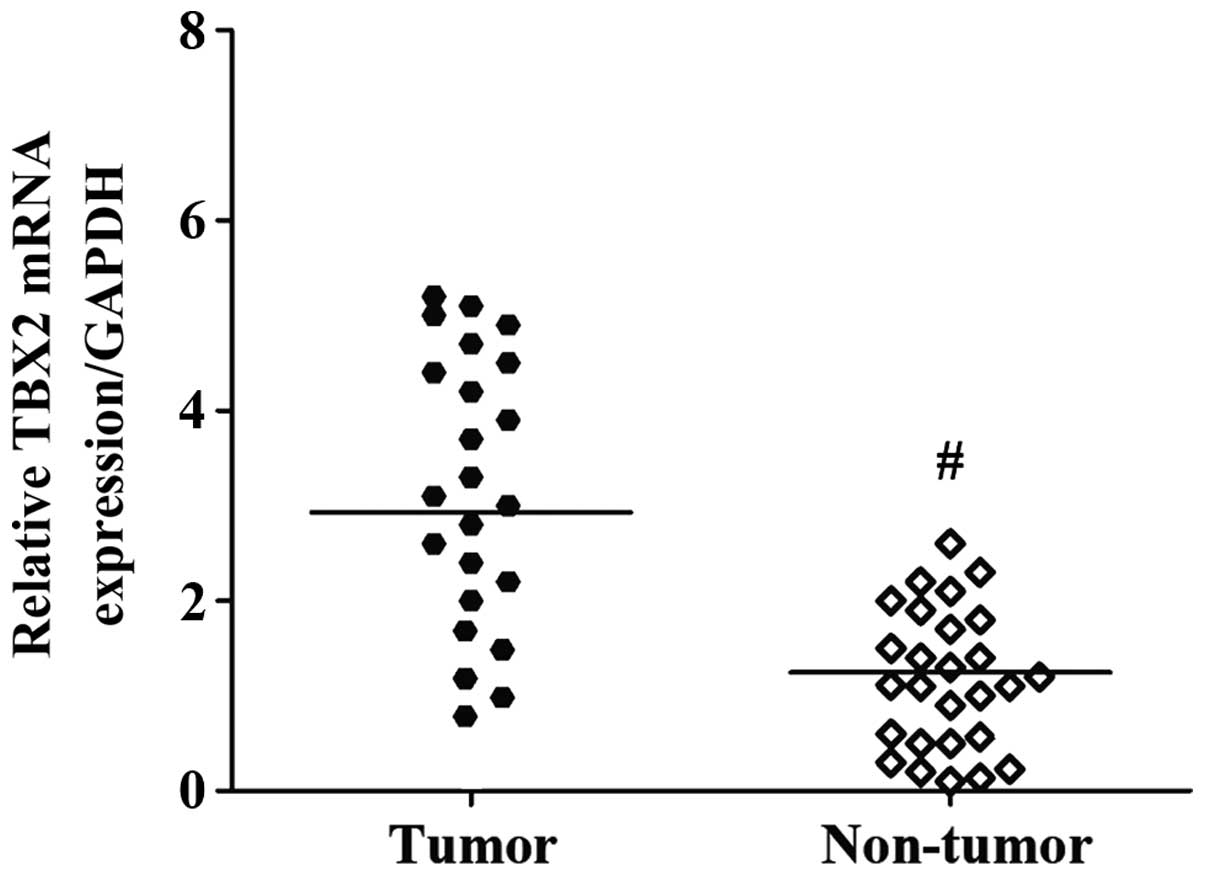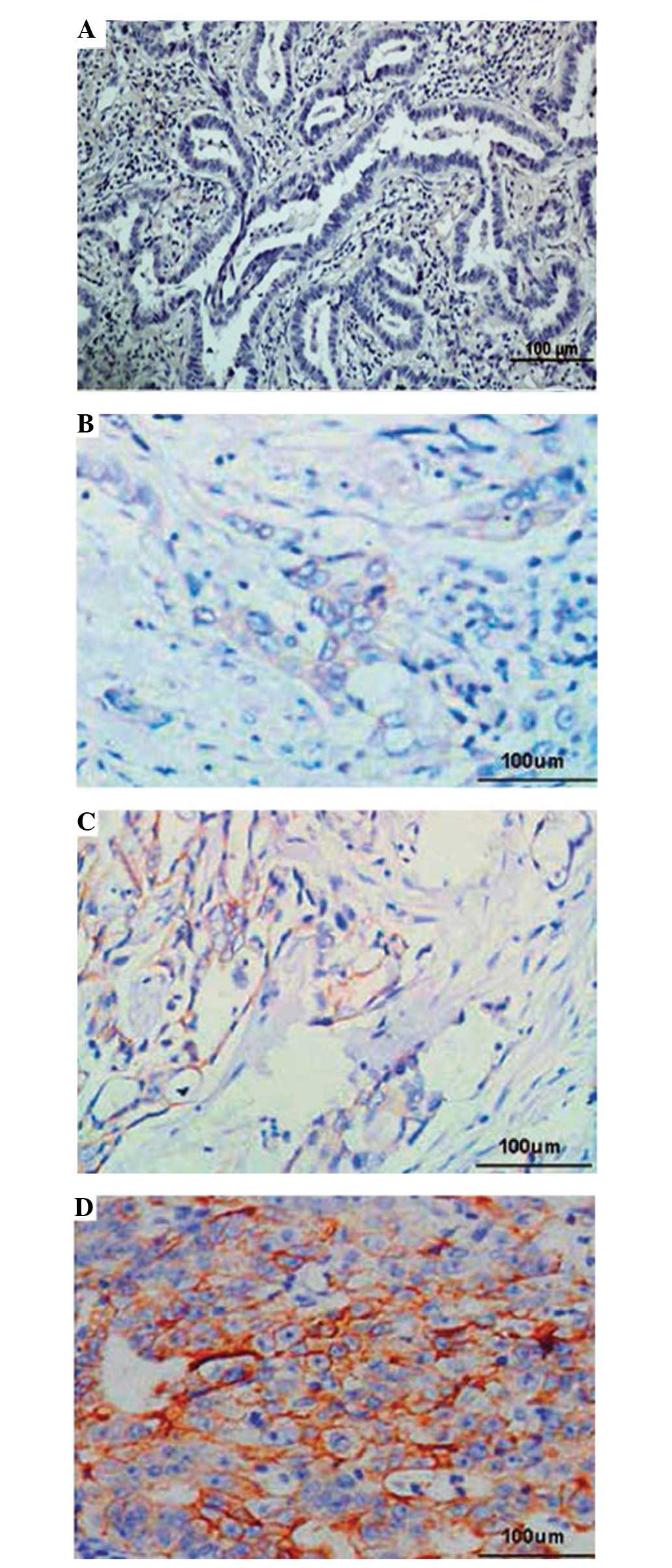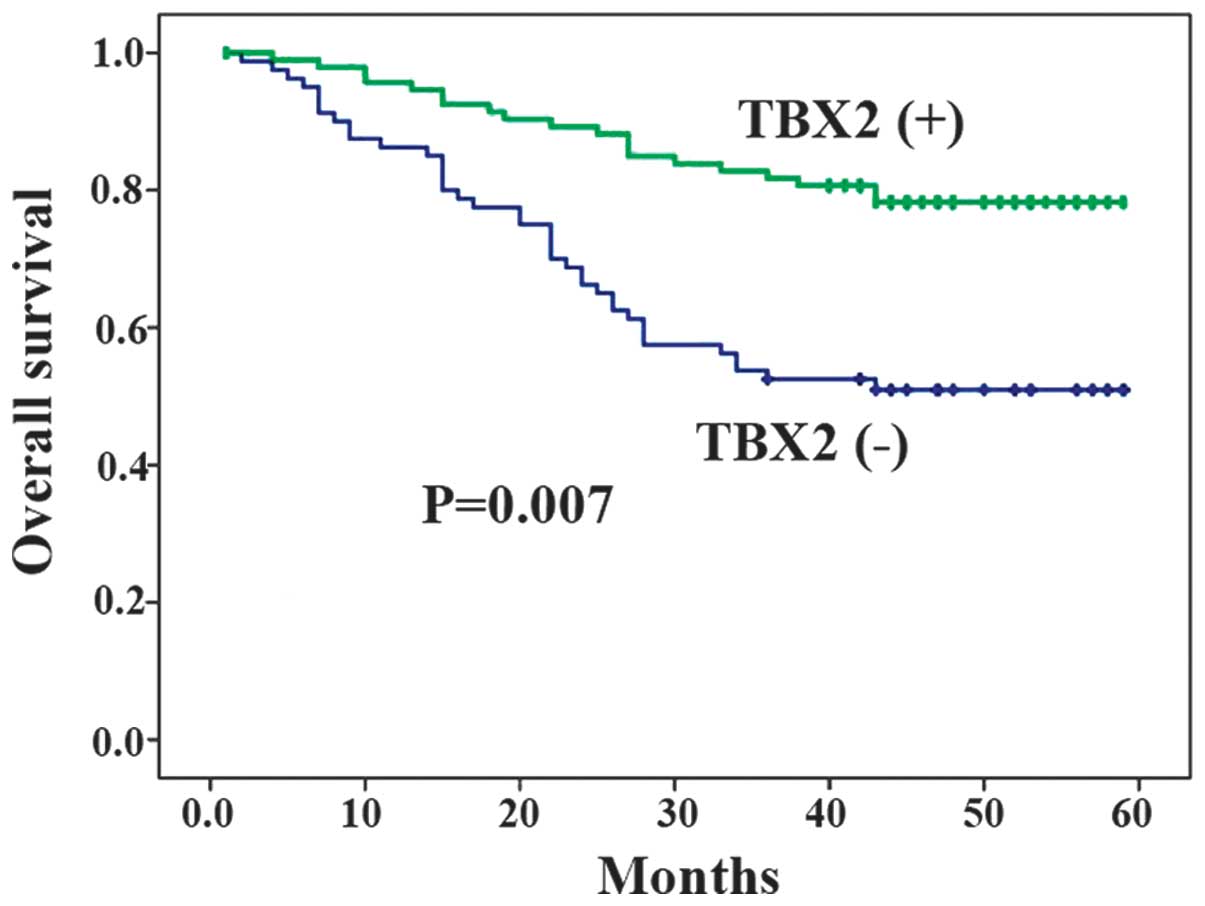T-box 2 expression predicts poor prognosis in gastric cancer
- Authors:
- Published online on: June 26, 2015 https://doi.org/10.3892/ol.2015.3428
- Pages: 1689-1693
Abstract
Introduction
Gastric cancer (GC) is an aggressively invasive tumor, and one of the most common lethal cancers worldwide (1–2). Surgical resection may successfully treat GC in the early stage of disease (3). However, a considerable number of patients with GC are diagnosed at an advanced stage of disease, resulting in a poor prognosis (4). Thus, exploring the potential novel markers of GC is critical to make an early diagnosis, guide the treatment regimens and predict the prognosis of patients with GC.
T-box 2 (TBX2) is a member of the T-box family of transcription factors, which are involved in embryonic development (5). In addition to playing a role in development, it has been suggested that TBX2 is involved in cell cycle regulation and cancer (6). Deregulated TBX2 gene expression is found in breast cancer (7), melanoma (8) and pancreatic cancer (9). However, the expression and role of TBX2 in GC have yet to be fully elucidated. In the present study, the expression of TBX2 in GC was investigated using reverse transcription-quantitative polymerase chain reaction (RT-qPCR), western blotting and immunohistochemistry. The correlation between the expression of TBX2 and the clinicopathological features of patients with GC was then analyzed.
Patients and methods
Patients
In total, 25 fresh samples of GC and paired adjacent non-cancerous tissues were obtained between May 1, 2013 and August 1, 2013 at Shandong Provincial Qianfoshan Hospital (Jinan, China), and used for RT-qPCR and western blot analysis to determine the TBX2 expression levels. In addition, tissue samples obtained from 266 patients that underwent surgery for the treatment of GC between January 1, 2004 and December 1, 2008 at Shandong Provincial Qianfoshan Hospital were used for immunohistochemical analysis. The group included 371 men and 245 women, with a mean age of 62.6±17.4 years. The present study was approved by the Ethics Committee of Shandong Provincial Qianfoshan Hospital and was performed in accordance with the 2000 Declaration of Helsinki (10). Written informed consent was obtained from all patients prior to surgery.
Follow-up
All tissue samples were used for immunohistochemical analysis. All patients underwent gastrectomy, and were monitored by chest, abdominal and pelvic computed tomography (CT) and blood testing at three-month intervals and yearly gastroscopy. The overall survival time was defined as the time between surgery and clinically or radiologically confirmed recurrence or metastasis, or mortality.
RT-qPCR
Total RNA was extracted using TRIzol reagent (Invitrogen, Carlsbad, CA, USA) and reverse transcribed into cDNA using the Reverse Transcription kit (Invitrogen). The cDNA was then amplified by RT-qPCR using the SYBR Green PCR kit (Invitrogen). The primers used for PCR were as follows: TBX2 forward, 5′-TGCGGAGAACTCCAGGTT-3′ and reverse, 5′-AGCTGGTGAGTGGAGCCA-3′; and GAPDH forward, 5′-ACAGTCAGCCGCATCTTCTTTTG-3′ and reverse, 5′-CCCACTTGATTTTGGAGGGATCT-3′. The data were analyzed using the ΔΔCt method and the expression of TBX2 was normalized against the GAPDH transcripts.
Western blot analysis
Fresh tumor sections obtained from 25 patients recently diagnosed with GC and the corresponding adjacent non-cancerous tissues were lysed in cell lysis buffer (Sigma-Aldrich, St. Louis, MO, USA). The samples were homogenized and then maintained at 4°C for 30 min. Cell extracts were centrifuged at 12,000 × g for 30 min at 4°C and the protein concentration was determined using a bicinchoninic acid kit (Pierce Biotechnology, Inc., Rockford, IL, USA). Total protein (50 µg) from each sample was heated at 95°C for 5 min subsequent to mixing with an equal volume of 2X SDS loading buffer. The samples were separated on 12.5% SDS-PAGE gels and transferred to polyvinylidene difluoride membranes (EMD Millipore, Billerica, MA, USA). The membrane was blocked in Tris-buffered saline with Tween 20 (TBS-T) containing 5% skim milk at room temperature for 2 h. The membranes were incubated with TBX2 antibody (dilution, 1:2,000) in TBS-T overnight at 4°C. Subsequent to washing with TBS-T, the membrane was incubated in 5% skim milk in TBS-T buffer containing a secondary antibody (dilution, 1:5,000) for 60 min at room temperature. Proteins of interest were detected using a Chemiluminescence Reagent Plus kit (Perkin Elmer, Beaconsfield, Buckinghamshire, UK). For normalization of protein loading, the monoclonal antibody against GAPDH (dilution, 1:5,000) was used.
Immunohistochemistry
Immunohistochemical analysis was performed on the formalin-fixed paraffin-embedded sections of GC tumor tissues and the corresponding adjacent benign tissue specimens. The slides were microwaved in citrate buffer antigen retrieval solution (Vector Laboratories, Inc., Burlingame, CA, USA) and washed with phosphate-buffered saline (PBS) for 5 min. The slides were then blocked with 10% normal goat serum in PBS for 30 min and incubated overnight in the presence of rabbit polyclonal IgG anti-TBX2 antibody (dilution, 1:50; cat no. sc-48780; Santa Cruz Biotechnology, Inc., Dallas, TX, USA). The slides were then washed three times using PBS and incubated with goat anti-rabbit secondary antibody (dilution, 1:500) for 30 min. The slides were counterstained with light green (Beijing Bitab Biotechnology Co., Ltd., Beijing, China) and evaluated semi-quantitatively based on the intensity and percentage of staining. The TBX2 staining was classified as strong (3+), moderate (2+), weak (1+) or absent (−) compared with the adjacent non-tumor tissues. Scores of 0 or 1+ were considered to indicate a lack of TBX2 expression, and scores of 2+ or 3+ were considered to indicate the presence of TBX2 expression. No staining was observed using the isotype control immunoglobulin G, indicating stain specificity.
Statistical analysis
The χ2 and Fisher's exact tests were used to compare categorical variables. Kaplan-Meier plot and log-rank tests were used for survival analysis. Univariate and multivariate analyses were based on the Cox proportional hazards regression model. Statistical analyses were performed using SPSS 15.0 software (SPSS, Inc., Chicago, IL, USA). P<0.05 was considered to indicate a statistically significant difference.
Results
Increased TBX2 mRNA and protein expression in human GC tissues
The mRNA level of TBX2 was determined by RT-qPCR in 25 fresh GC specimens and paired corresponding adjacent non-cancerous gastric tissues. The TBX2 gene expression level was significantly increased in the cancerous tissues compared with the adjacent non-cancerous tissues (P<0.001; Fig. 1).
Furthermore, western blot analysis was performed on the aforementioned specimens. Consistently, the results revealed that the expression of the TBX2 protein was significantly increased in the GC tissues compared with the matched adjacent non-cancerous tissues, as semi-quantified by densitometry (P<0.001; Fig. 2).
Immunohistochemical analysis of TBX2 expression and the association with clinicopathological parameters
To investigate the clinicopathological significance of TBX2 expression, immunohistochemical analysis was performed using 266 paraffin-embedded GC tissue blocks. The results of the immunohistochemical analysis were graded for the expression of TBX2 as without TBX2 expression or positive for TBX2 expression. As revealed in Fig. 3, the expression rate of TBX2 in GC samples was 66.2% (176/266). By contrast, only 8.27% (22/266) of paired adjacent non-cancerous tissues exhibited TBX2 expression. The association between the expression of TBX2 and various clinicopathological parameters is listed in Table I. The results revealed that the increased expression of TBX2 was significantly associated with the clinical stage of disease (P=0.022), incidence of vascular invasion (P=0.031) and presence of metastasis (P=0.005).
Table I.Association between TBX2 expression and clinicopathological parameters in 266 patients with gastric cancer. |
Association between TBX2 expression and prognosis, as determined using the Cox proportional hazards model
The prognostic effect of TBX2 expression on the survival of patients with GC was analyzed. The results revealed that the overall survival time of the patients with GC that demonstrated TBX2 expression was shorter compared with the survival time of patients without TBX2 expression (P=0.007; Fig. 4).
Univariate analysis revealed that the overall survival time of patients was significantly associated with the tumor stage and presence of vascular invasion, metastasis and expression of TBX2 (Table II). In addition, the association between the presence of TBX2 expression and survival time was found to remain significant subsequent to controlling other prognostic factors in multivariate analysis [hazard ratio (HR), 3.930; 95% confidence interval (CI), 2.041–7.917; P=0.009; Table III]. Multivariate analysis also revealed metastasis and vascular invasion to be independent prognostic factors.
Discussion
Evolutionarily conserved genes perform critical and well-established roles in embryonic development. T-box factors have gained increasing prominence in the field of cancer biology, as a wide range of cancers exhibit deregulated expression of T-box factors that possess tumor suppressor or tumor promoter functions. TBX2 is one of the best characterized members of the T-box family of transcription factors and contributes directly to tumor progression, and particularly to the suppression of senescence and control of invasiveness (11). TBX2, located at 17q23, has been revealed to be highly amplified and overexpressed in breast cancer cell lines through fluorescence in situ hybridization (FISH) (12). Jacobs et al (7) revealed that TBX2 was amplified in a subset of primary human breast cancers, indicating that this gene may contribute to breast cancer development. In addition, Vance et al (13) found that TBX2 was poorly expressed in the melanocyte cell line, while it was overexpressed in all melanoma cell lines tested. This study also found that TBX2 played an important role in maintaining cell proliferation and suppression of senescence in melanomas. Furthermore, Mahlamaki et al (9) detected that TBX2 was amplified in 50% of pancreatic cancer cell lines tested by FISH. TBX2 was also overexpressed in several cancers, including breast and pancreatic cancers and melanoma, where TBX2 was demonstrated to function as a tumor-associated gene. Furthermore, Duo et al (14) reported previously in pancreatic cancer that TBX2 was closely associated with the degree of tumor differentiation, increased TNM stage and presence of distant metastasis. However, extremely little is known on the deregulation of TBX2 in GC.
In the present study, TBX2 expression was measured in fresh frozen specimens of GC and it was found that the expression levels of TBX2 mRNA and protein in GC tumor tissues were increased compared with the corresponding non-cancerous mucosa. It was suggested that TBX2 was upregulated at the transcriptional and post-transcriptional levels. Additional validation by immunohistochemistry revealed that 66.2% (176/266) of GC tissues exhibited positive staining, while only 8.27% (22/266) of the matched non-cancerous tissues were immunoreactive for TBX2. These data indicated that TBX2 may be involved in the progression of gastric carcinogenesis. In the present study, the association between TBX2 expression and the clinicopathological features of GC was also analyzed. The current results revealed a correlation between the expression of TBX2 in tumors and the clinical tumor stage, and a correlation between vascular invasion and distant metastasis. These data indicate that upregulated expression of TBX2 may contribute to the invasion and metastasis of tumors. Therefore, TBX2 may be a possible biomarker for the identification of subsets of colon cancer with a more aggressive phenotype. Consistent with the present results, Dimova et al (15) identified TBX2 to be a specific genomic marker for late-stage ovarian cancers. Similarly, Kandimalla et al (16) recognized TBX2 expression as a pTa stage-specific prognostic marker in bladder cancer.
Overall, the present study revealed that patients with tumors expressing TBX2 demonstrated a worse survival rate compared with patients without TBX2 expression. In addition, TBX2 expression was strongly associated with an increased risk of tumor invasion and metastasis compared with the absence of TBX2 expression. Using the univariate and multivariate Cox model analysis, it was confirmed that TBX2 may act as a significant independent prognostic factor for patients with GC.
References
|
Liang JW, Gao P, Wang ZN, Song YX, Xu YY, Wang MX, Dong YL and Xu HM: The integration of macroscopic tumor invasion of adjacent organs into TNM staging system for colorectal cancer. PLoS One. 7:e522692012. View Article : Google Scholar : PubMed/NCBI | |
|
Jemal A, Bray F, Center MM, Ferlay J, Ward E and Forman D: Global cancer statistics. CA Cancer J Clin. 61:69–90. 2011. View Article : Google Scholar : PubMed/NCBI | |
|
Sun J, Jiang T, Qiu Z, Cen G, Cao J, Huang K, Pu Y, Liang H, Huang R and Chen S: Short-term and medium-term clinical outcomes of laparoscopic-assisted and open surgery for colorectal cancer: A single center retrospective case-control study. BMC Gastroenterol. 11:852011. View Article : Google Scholar : PubMed/NCBI | |
|
Popa F, Bratucu M and Radu P: Present and future tense in operable rectal cancer. Chirurgia (Bucur). 106:11–16. 2011.PubMed/NCBI | |
|
Rowley M, Grothey E and Couch FJ: The role of Tbx2 and Tbx3 in mammary development and tumorigenesis. J Mammary Gland Biol Neoplasia. 9:109–118. 2004. View Article : Google Scholar : PubMed/NCBI | |
|
Abrahams A, Parker MI and Prince S: The T-box transcription factor Tbx2: Its role in development and possible implication in cancer. IUBMB Life. 62:92–102. 2010.PubMed/NCBI | |
|
Jacobs JJ, Keblusek P, Robanus-Maandag E, Kristel P, Lingbeek M, Nederlof PM, van Welsem T, van de Vijver MJ, Koh EY, Daley GQ and van Lohuizen M: Senescence bypass screen identifies TBX2, which represses Cdkn2a (p19(ARF)) and is amplified in a subset of human breast cancers. Nat Genet. 26:291–299. 2000. View Article : Google Scholar : PubMed/NCBI | |
|
Vance KW, Carreira S, Brosch G and Goding CR: Tbx2 is overexpressed and plays an important role in maintaining proliferation and suppression of senescence in melanomas. Cancer Res. 65:2260–2268. 2005. View Article : Google Scholar : PubMed/NCBI | |
|
Mahlamäki EH, Bärlund M, Tanner M, Gorunova L, Höglund M, Karhu R and Kallioniemi A: Frequent amplification of 8q24, 11q, 17q and 20q-specific genes in pancreatic cancer. Genes Chromosomes Cancer. 35:353–358. 2002. View Article : Google Scholar : PubMed/NCBI | |
|
Salako SE: The declaration of Helsinki 2000: Ethical principles and the dignity of difference. Med Law. 25:341–354. 2006.PubMed/NCBI | |
|
Wansleben S, Peres J, Hare S, Goding CR and Prince S: T-box transcription factors in cancer biology. Biochim Biophys Acta. 1846:380–391. 2014.PubMed/NCBI | |
|
Bärlund M, Monni O, Kononen J, Cornelison R, Torhorst J, Sauter G, Kallioniemi OLLI-P and Kallioniemi A: Multiple genes at 17q23 undergo amplification and overexpression in breast cancer. Cancer Res. 60:5340–5344. 2000.PubMed/NCBI | |
|
Vance KW, Carreira S, Brosch G and Goding CR: Tbx2 is overexpressed and plays an important role in maintaining proliferation and suppression of senescence in melanomas. Cancer Res. 65:2260–2268. 2005. View Article : Google Scholar : PubMed/NCBI | |
|
Duo S, Tiao-Dong T, Lei Z, Wei W, Hong-Li S and Xian-Wei D: Expression and clinical significance of tbx2 in pancreatic cancer. Asian Pac J Cancer Prev. 10:118–122. 2009.PubMed/NCBI | |
|
Dimova I, Orsetti B, Negre V, Rouge C, Ursule L, Lasorsa L, Dimitrov R, Doganov N, Toncheva D and Theillet C: Genomic markers for ovarian cancer at chromosomes 1, 8 and 17 revealed by array CGH analysis. Tumori. 95:357–366. 2009.PubMed/NCBI | |
|
Kandimalla R, van Tilborg AA, Kompier LC, Stumpel DJ, Stam RW, Bangma CH and Zwarthoff EC: Genome-wide analysis of CpG island methylation in bladder cancer identified TBX2, TBX3, GATA2 and ZIC4 as pTa-specific prognostic markers. Eur Urol. 61:1245–1256. 2012. View Article : Google Scholar : PubMed/NCBI |













